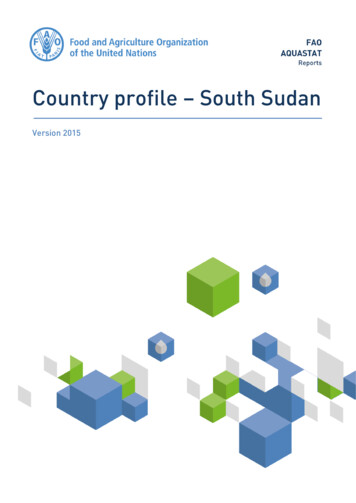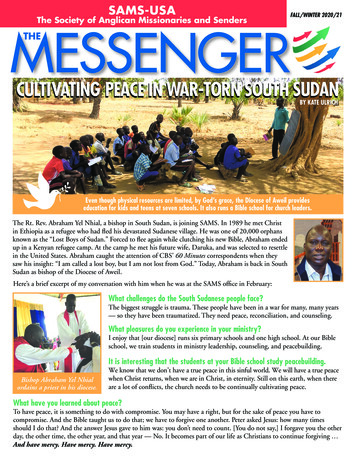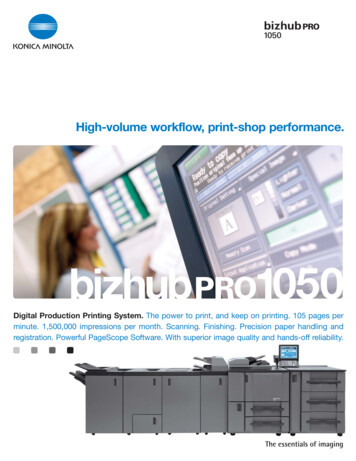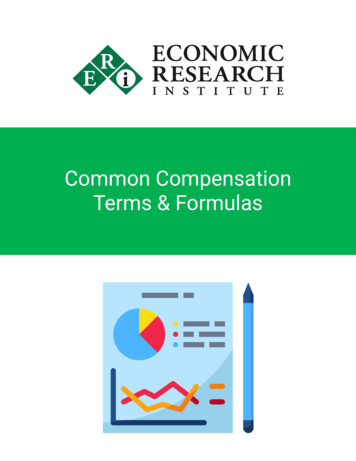
Transcription
SUDANStaple Food MarketFundamentals2015
About FEWS NETCreated in response to the 1984 faminesin East and West Africa, the Famine EarlyWarning Systems Network (FEWS NET)provides early warning and integrated,forward-looking analysis of the manyfactors that contribute to food insecurity.FEWS NET aims to: inform decisionmakers and contribute to their emergencyresponse planning; support partners inconducting early warning analysis andforecasting; and provide technicalassistance to partner-led initiatives.To learn more about the FEWS NETproject, please visit http://www.fews.netDisclaimerThis publication was prepared under theUnited States Agency for InternationalDevelopment Famine Early WarningSystems Network (FEWS NET) IndefiniteQuantity Contract, AID-OAA-I-12-00006.The author’s views expressed in thispublication do not necessarily reflect theviews of the United States Agency forInternational Development or the UnitedStates government.AcknowledgmentsFEWS NET gratefully acknowledges thenetwork of partners in Sudan whocontributed their time, analysis, and datato make this report possible. See the listof participants and their organizations inAnnex 1.ii
Table of ContentsKEY MESSAGES . VIPREFACE . VIIIKEY CONCEPTS .XI1. SUDAN STAPLE FOOD MARKET FUNDAMENTALS . 11.11.21.3INTRODUCTION . 1NATIONAL FOOD SUPPLY . 1NATIONAL FOOD DEMAND . 32. CROSS-CUTTING ISSUES . 52.12.22.32.42.52.6AGROCLIMATOLOGY . 5STORAGE . 6AGRICULTURAL FINANCING . 7CONFLICT. 7FOOD AID . 9MACROECONOMY . 103. SORGHUM . 123.13.23.33.43.5KEY ACTORS IN SUDAN’S SORGHUM MARKETS . 12KEY SORGHUM TRADE MARKETS . 13DOMESTIC TRADE FLOWS . 13REGIONAL AND INTERNATIONAL TRADE FLOWS . 14SORGHUM PRICE TRENDS . 164. WHEAT . 184.14.24.34.44.54.6WHEAT CONSUMPTION TRENDS . 18WHEAT PRODUCTION TRENDS . 19WHEAT IMPORT TRENDS . 19KEY ACTORS IN SUDAN’S WHEAT MARKETS . 20KEY WHEAT TRADE MARKETS . 21WHEAT PRICE TRENDS . 225. MILLET . 255.15.25.35.4KEY ACTORS IN SUDAN’S MILLET MARKETS . 25KEY MILLET TRADE MARKETS . 26MILLET MARKETING . 28MILLET PRICE TRENDS. 286. KEY REMAINING INFORMATION GAPS . 297. MARKET MONITORING PLAN . 29ANNEX 1. WORKSHOP PARTICIPANTS’ NAMES AND ORGANIZATIONS . 32ANNEX 2. DATA COLLECTION AND INFORMATION VERIFICATION METHODS . 33REFERENCES . 34iii
List of FiguresFigure 1 Map of Sudan’s states . viFigure 2 FEWS NET’s approach to market monitoring and analysis . viiiFigure 3 FEWS NET presence and remote monitoring countries .ixFigure 4 Average rainfall levels in Sudan . 5Figure 5 Seasonal calendar for Sudan . 6Figure 6 In-kind wheat and sorghum assistance, 2000-2012 . 8Figure 7 Sorghum price ratios and in-kind food aid deliveries . 8Figure 8 Contributions to the GoS budget (millions of SDG) . 10Figure 9 Sudanese macroeconomic indicators, 2010-2013 . 10Figure 10 Average sorghum production (MT) and prices (SDG/90-kg bag), by state . 12Figure 11 Sudan’s sorghum marketing channels . 13Figure 12 Sudan sorghum production and trade flow map . 15Figure 13 Average seasonal sorghum price index in Gedaref, Sudan (2008-2013) . 16Figure 14 Sorghum prices in Sudan (SDG/kg), 2008-2014 . 16Figure 15 Average wheat production (MT) and prices (SDG/100-kg bag), by state, 2009/10-2013/14. 18Figure 16 Average seasonal wheat price index in Dongola, Sudan . 19Figure 17 Sudan’s wheat production imports and consumption (000s MT),1994-2013 . 20Figure 18 Local wheat and import parity prices (SDG/kg). 20Figure 19 Sudan’s wheat marketing channels . 21Figure 20 Wheat prices in Sudan (SDG/kg), 2008-2014 . 22Figure 21 Sudan local wheat production and trade flow map . 24Figure 22 Average millet production (MT) and prices (SDG/90-kg bag), by state, 2009/10-2013/14 . 25Figure 23 Sudan’s millet market actors . 26Figure 24: Average Seasonal Millet Price Index in Nyala, Sudan . 26Figure 25 Sudan millet production and market flow map. 27Figure 26 Millet prices in Sudan (SDG/kg), 2008-2014 . 28Figure 27 FEWS NET’s approach to market monitoring and analysis . 30List of TablesTable 1 Sudan commodity balance sheet (000s MT), 2009/10-2013/14 . 1Table 2 Average cereal production (000s MT) by sector, 2008/09-2012/13 . 2Table 3 Months of market dependence for sorghum and wheat by poor rural households in Sudan, by LivelihoodZone . 2Table 4 Average cereal deficit in Sudan (000s MT), by state. 3Table 5 Coefficient of variation of cereals production, 2000-2013. 5Table 6 Price variability in 2013/14 versus 2012/13 (coefficient of variation; Nov-May prices) . 9Table 7 Sorghum price correlations in Sudan . 17Table 8 Wheat price correlations in Sudan . 22Table 9 Millet price correlations in Sudan . 29Table 10 Sudan market monitoring plan . 30iv
Acronyms and AbbreviationsABS Agricultural Bank of SudanACFSAM Annual Crop and Food Supply Assessment MissionDRA Darfur Development and Reconstruction AgencyFAO Food and Agriculture Organization of the United NationsFARMERS Food and Agricultural Realtime Messaging and Reporting SystemFEWS NET Famine Early Warning Systems NetworkFSTS Food Security Technical SecretariatGoS Government of SudanIMF International Monetary Fundkg kilogramMoA Ministry of Agriculturemm millimeterMT metric tonMMT million metric tonsNGO nongovernmental organizationRM Remote MonitoringSDG Sudanese poundSRC Strategic Reserve CorporationSIFSIA Sudan Institutional Capacity Programme: Food Security Information for ActionUSD United States dollarWFP World Food ProgrammeWFP/VAM World Food Programme Vulnerability Assessment and Mapping Unitv
FEWS NET SUDAN Staple Food Market FundamentalsKey Messages2015Figure 1 Map of Sudan’s states The three main staplefoods in Sudan aresorghum, wheat, andmillet. As a country,Sudan is structurallydeficit in staple foodproduction, althoughimportant commodityspecific and geographicdifferences exist. Inaggregate terms, Sudanis surplus-producing insorghum, self-sufficientinmillet,andstructurally deficit inwheat. Khartoum is the largestconsumption center inSudan,whiletheeastern Gedaref andSennarStatesconsistently produce asurplus (mostly inSource: WFP/VAM Sudan 2014.sorghum), which is soldelsewhere in the country and region, and regularly exported to the Gulf States (Figure 1). The Darfur Stateswere once self-sufficient in grain production. Many years of conflict and civil unrest have significantlydisrupted production and marketing systems in Darfur, and the populations that remain there rely heavily onimports from elsewhere in the country and on relief commodities. Despite many advances in agricultural production technologies (semi-mechanized and irrigated productionschemes), local rainfall patterns remain a key driver in domestic food availability and prices. Rainfallpatterns can vary widely from year to year (up to 30 percent from average), resulting in highly variableproduction and market supply patterns. Other factors that influence food availability and access (prices) include persistent civil unrest and conflict(particularly in Darfur and Kordofan States), the effects of longstanding economic sanctions, andmacroeconomic instability most recently attributed to substantial reductions in government revenues fromdecreased oil sales. Oil revenues are a main source of hard currency through which the Sudanese governmentmakes purchases of essential goods for its population. The presence of economic sanctions makes itincreasingly difficult for businesses engaged in sectors that are not directly affected (food and agriculturalinputs) to carry out their activities. The wheat marketing system is structured much differently than that of local cereals and includes two mainchannels. The first is imported wheat, which accounts for 75-85 percent of wheat supply; the second is localFamine Early Warning Systems Networkvi
FEWS NET SUDAN Staple Food Market Fundamentals2015production, which accounts for 15-25 percent of wheat supply). Imported wheat marketing involves stronglinkages between three large milling firms and the Government of Sudan (GoS). A decade of civil unrest and conflict have left the Darfur States relatively more isolated from the nationalstaple food marketing system. Local production and marketing systems have been significantly affected,resulting in major food deficits that are not always met through commercial trade flows. Food aid (in-kind) appears to have had positive impacts on markets by assuring food supplies during yearsof production shortfalls and periods of severe crisis. Recent anecdotal evidence indicates that the use of cashtransfers and vouchers in 2013/14 (a very poor production year) may have aggravated food price increasesand variability in the Darfur States. Additional research is needed to understand the impacts of cash transfers and vouchers on markets andprices during years of good versus poor national grain production. This will help inform the design of suchprograms in future years, when both local and national production are significantly below average. Additionalresearch is likewise needed to understand the importance of livestock consumption in total grain demand.This will help improve the parameters used to estimate the annual national grain surplus, and hence externalgrain needs.Famine Early Warning Systems Networkvii
FEWS NET SUDAN Staple Food Market Fundamentals2015PrefaceMarkets and trade information and analysis are key inputs in FEWS NET’s integrated food security analysis.FEWS NET relies on a common understanding of a given population’s livelihoods (food and income sources andtypical coping strategies used to handle shocks) as well as an understanding of typical market conditions andoutcomes. Together, these are used to identify and quantify the magnitude of market-based anomalies and theirpotential impacts on food security outcomes of the poor and very poor (Figure 2).Figure 2 FEWS NET’s approach to market monitoring and analysisFEWS NET’s Approach to Market Monitoring and AnalysisBuild Marketsand itor andanalyzemarkets andpricesProvide timelyinputs tointegrated foodsecurity analysisand decisionsupportSeveral types of information help inform the understanding of typical market conditions that affect the foodand income sources of the poor and very poor. These include: the geography of supply and demand for aparticular commodity (for example, maize) or category of commodities (for example, staple foods); the role ofdifferent actors in the marketing system (from small-scale producers to industrial food processors); theseasonality of specific events or activities; aggregate import-dependence, particularly in the case of staple foods;and key programs and policies. These factors affect the stability of food availability and access (food prices andincome levels) and therefore three of the four pillars of food security (food availability, access, utilization, andstability). Collectively, an understanding of these key elements constitutes the FEWS NET Markets and TradeKnowledge base.During FEWS NET III (FY 2012-FY 2016), Markets and Trade Knowledge base information is compiled into“Market Fundamentals” reports that seek to provide readers with a general understanding of market dynamicsduring a typical year. These consolidated documents are elaborated for both presence and remote monitoring(RM) countries, with references to relevant external documents and resources when they are available. Two pilotswere carried out in FY 2014, one in Sudan and one in Burkina Faso, to test the appropriateness of the approach,the usefulness of the end products, and the level of effort required.During the first year of rollout (FY 2015), the Market Fundamentals reports will focus largely on staple foodmarket structure and behavior. Such reports can be prepared for cash crop, livestock, and labor markets followinga similar approach. Of particular interest to the FEWS NET project are markets identified as important sources offood and income for the poor and very poor based on an understanding of the livelihoods of those populations.The Markets and Trade Knowledge team’s vision is to eventually have a staple food Market Fundamentals reportfor each FEWS NET country and region. Other reports (focusing on cash crop, livestock, and labor markets) will beadded in a modular fashion as time and resources permit.Famine Early Warning Systems Networkviii
FEWS NET SUDAN Staple Food Market Fundamentals2015FEWS NET monitors markets in presence as well as remote monitoring (RM) countries. A presence countryis monitored by FEWS NET staff working in a local country office. RM countries are typically covered by analystsin a nearby country using a lighter analytical approach to identify anomalies and deteriorating conditions.FEWS NET also monitors staple food markets in other countries or regions that are relevant to understandingfood availability and access for the poor and very poor in FEWS NET countries (for example, Benin, Pakistan,Kazakhstan, South Africa, and Mexico, among others).Figure 3 FEWS NET presence and remote monitoring countriesSource: FEWS NET 2014.The Market Fundamentals reports will continue to inform the project’s regular market monitoring in terms ofthe commodities covered in the project’s Markets and Trade Knowledge data warehouse, Price Bulletins, PriceWatch, and special reports (Figure 2). The specific markets and commodities covered in country-specific reportswill depend on a number of factors. The reports focusing on staple food markets touch on the following: Cross-cutting issues that affect all markets in a given country or region: The political and macroeconomicenvironment and key national-level programs and policies that influence food and income sources. For each commodity marketoMarket structure, including the relative importance of local production versus imports in aggregate foodavailability and access, including the geographic distribution of production and consumption, and keyactors in the marketing chain.oMarket behavior/conduct, including purchase or selling behavior of key actors present in the marketingchain.Famine Early Warning Systems Networkix
FEWS NET SUDAN Staple Food Market Fundamentals 2015oMarket performance outcomes, including production trends, inter- and intra-annual price variability, andregional or international competitiveness.oKey indicators that analysts need to monitor over the course of the marketing year that could affect foodavailability and access of the poor and very poor.FEWS NET’s widely recognized production and trade flow maps are incorporated into the report forcommodities produced and consumed both locally and regionally as a means of illustrating the relativeimportance of certain markets and trade flow patterns in assuring food availability and access throughout thecountry. However, when a commodity is grown almost entirely as an exported cash crop or imported almostexclusively from international markets, other relevant diagrams and illustrations are used.Famine Early Warning Systems Networkx
FEWS NET SUDAN Staple Food Market Fundamentals2015Key ConceptsThe following provides the definitions of several key terms used throughout the report. For more detail on thesedefinitions and other useful terms, consult the FEWS NET Markets and Trade Glossary.Marketing system: This includes the entire commodity distribution system from production to consumption. Amarketing system describes the key actors and the linkages between different stages of the distribution processof a given commodity. The marketing system also describes the spatial and functional relationships betweenmarket actors.Marketing year: This refers to the period during which agricultural production from a given year’s harvest issold. This period typically extends from one harvest of a particular commodity to the next, and is very similar tothe consumption year used in FEWS NET’s livelihoods work in many cases.Unimodal areas: Unimodal areas are agro-ecological zones with one distinct rainy season with one rainfall peakand typically a single harvest.Bimodal areas: Bimodal areas are agro-ecological zones with either a single prolonged rainy season with tworainfall peaks or two or more distinct rainy seasons (which could each be unimodal or bimodal), resulting in twoor more harvests. The amount of rainfall can be equivalent between rainy seasons or one may be dominant (forall commodities or for a single crop), resulting in differing yields between seasons.Commodity-specific classifications of surplus and deficit areas are established based on historical productionfigures and on FEWS NET staff and key informants’ knowledge of the consumption patterns of particular areasof a given country. When surplus and deficit areas are identified in aggregate, the determination is typically basedon total local production, expressed in kilocalorie terms, compared to total local needs (also expressed inkilocalorie terms). Estimated staple food needs are typically established by local governments and updated asconsumption patterns change.Surplus-producing area: A geographic area that produces sufficient quantity of a given commodity (or set ofcommodities, like cereals) to cover local demand and to supply other areas. An area can likewise be defined aseither having a minor surplus, meaning that in a normal year slightly more of a commodity is produced thanrequired to meet local needs, or as having a major surplus, meaning that production in a given area largelysurpasses local needs.Deficit area: A geographic area that does not produce enough of a given commodity to meet local demand.Self-sufficient area: A geographic area that produces sufficient quantity of a commodity to cover local demand.This area rarely produces: (1) enough to either supply other areas; or (2) too little to meet local needs.Market typesReference market: A market that provides information about supply, demand, and price conditions in othernearby markets or key markets that influence the performance of others.Collection market: A rural market where relatively smaller-scale traders (or trader agents) purchase directlyfrom producers.Assembly market: A market where relatively smaller quantities of a commodity are accumulated or aggregated,usually from different farmers and small-scale traders.Wholesale market: A market where traders generally sell to traders. The volumes traded in each transactiontend to be relatively larger (for example, multiple 50-kg bags and even metric tons).Famine Early Warning Systems Networkxi
FEWS NET SUDAN Staple Food Market Fundamentals2015Retail market: A market where commodities are sold directly to consumers. The volumes traded during eachtransaction tend to be relatively small (for example, per kg or locally used bowl or other unit of measure).Formal versus informal trade flowsFormal trade flows: Formal trade flows typically involve the exchange of large quantities of a given commodity,transported by road, rail, or sea. These trade flows are inspected, taxed, and reported in official governmentstatistics, and abide by the requirements of the local legal system (including national-level laws and regionaltrade agreements). For example, in some countries, an importer or exporter is required to obtain a license fromthe local government or regional trade body that gives authority to engage in import or export activities. Formaltrade can often also be thought of as legal trade.Informal trade flows: Informal trade flows typically occur outside of the formal trade system (described above).These exchanges are typically not recorded in official government import and export statistics and are notinspected and taxed through official channels. These trade flows are typically undocumented, unlicensed, andunregistered. Informal trade flows can vary from very small quantities carried by bicycle across small bordercrossing areas or via barge in large volumes exchanged over long distances.Trade flow magnitude and frequencyLarge trade flows: The volumes traded (through either formal or informal channels) are estimated to be (inqualitative terms) more important than other trade flow volumes in aggregate terms over the period of analysis.In unimodal FEWS NET countries, this represents the relative importance of trade flows between differentgeographic areas over a given marketing year. In bimodal areas, these may be season-specific. Because it is notpossible to estimate actual trade flow volumes between markets in most FEWS NET countries, these areestimated based on discussions with key informants familiar with the staple food market system of a givencountry or region.Medium trade flows: The volumes traded (through either formal or informal channels) are estimated to be (inqualitative terms) somewhere in between large and small flows in terms of the aggregate volumes traded overthe period of analysis. These are estimated through the same process as large trade flows (above).Small trade flows: The volumes traded (through either formal or informal channels) are estimated to be (inqualitative terms) less important than other trade flow volumes in aggregate terms over the period of analysis.These are estimated through the same process as large trade flows (above).Occasional trade flows: These trade flows either take place during very specific times of year (for exam
MARKET MONITORING PLAN . 29 ANNEX 1. WORKSHOP PARTICIPANTS' NAMES AND ORGANIZATIONS . ABS Agricultural Bank of Sudan . ACFSAM Annual Crop and Food Supply Assessment Mission . DRA Darfur Development and Reconstruction Agency .










